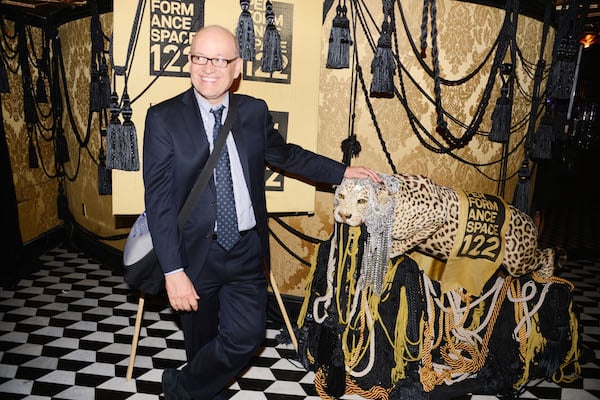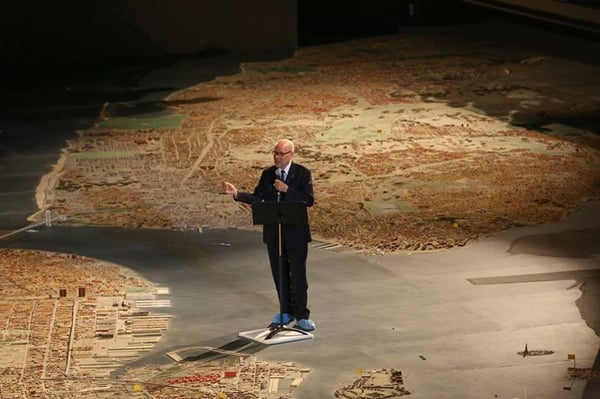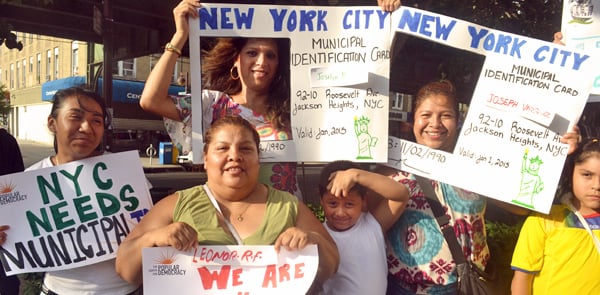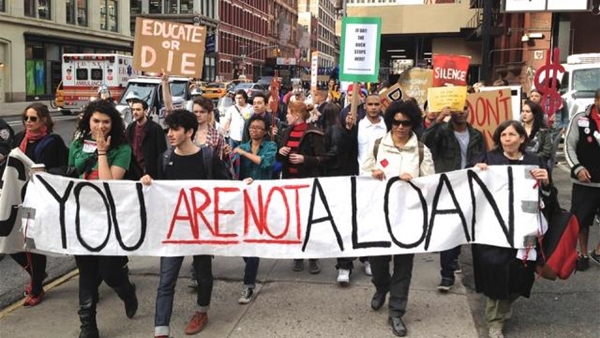Art World
Tom Finkelpearl Promises to Make New York Livable for Artists
The new culture czar also wants to get artists involved in disaster relief.

Photo: © 2014 Patrick McMullan Company, Inc.
The new culture czar also wants to get artists involved in disaster relief.

Benjamin Sutton

Tom Finkelpearl, the new commissioner of New York City’s Department of Cultural Affairs (DCA), believes artists can save the city. And he’s making news. Last week his department launched CultureAID (Culture Active in Disasters), a program conceived in the aftermath of Superstorm Sandy. A collaboration with the city’s Office of Emergency Management and FEMA’s Sandy Recovery Office, the initiative aims to formalize the essential role artists and arts organizations played in relief efforts after Sandy in anticipation of future disasters. In the lead up, Finkelpearl sat down with artnet News to offer a wide-ranging look into how he was approaching his new job, including thoughts on CultureAID, creating a more expansive vision for arts funding in New York, the Department of Cultural Affairs’s contribution to the city’s proposed new Municipal ID Card, and more.
ARTISTS TO THE RESCUE!
“I have a place in Rockaway, and I witnessed what happened after the storm first-hand on a day-to-day basis, with Occupy Sandy and Klaus Biesenbach bringing materials down there, and the Rockaways Surf Club, all of which was incredible, there was all this volunteer work going on,” Finkelpearl, the former director of the Queens Museum who began his job as culture commissioner under mayor Bill DeBlasio in April, told artnet News recently. “The Queens Museum did a very quick benefit on behalf of the Rockaway Waterfront Alliance and raised $65,000 in four weeks. But what was needed was not $65,000, it was $65 billion. So these billions and billions of dollars are what was necessary, and it pointed to me the difference between community action—and a lot of community action was done by artists and arts groups—and government action. Both are extremely important, and community action by the artists was very psychologically valuable, just this idea that some hipsters are showing up on your front porch saying, ‘We’re here to help.’”
CultureAID will make it easier for artists and arts organizations to help, both with disseminating disaster preparation information and in relief efforts. The initiative is emblematic of Finkelpearl’s approach, which he honed during his 12-year tenure as the executive director of the Queens Museum. He sees artists and cultural organizations as vital not only for the economic benefits they bring to the city—a popular argument for arts funding during the Michael Bloomberg era—but also because of the integral roles they play in their communities.

Tom Finkelpearl standing on the New York City diorama at the Queens Museum.
Photo: Dominick Totino/Queens Museum.
MORE THAN MONEY
“The city has been extremely good at measuring the economic impact of the arts, and I believe it, I really believe it,” Finkelpearl says. “Tourism is important to the economy, and arts are important to tourism, and it’s measurable, and that case has been made quite well. The counterargument to that is: Nobody got into the arts because it’s good for the economy. You got into the arts because of a particular artistic experience, the intrinsic rather than the instrumental value of the arts. The instrumental is that it’s good for the economy, and the intrinsic is that something happens that’s not measurable when you’re at the ballet or looking at a painting. The problem with making the economic argument is, if you’re basing your entire argument on that and you say, “We should build a new museum because it’s good for the economy,” well, it might be more advantageous for the economy to build a stadium. And I’m not saying I agree with that, but there are other things you can argue for economically that might be just as good or better than the arts. So therefore we have to look at what’s inherent in the arts. But in between there is this idea of the social value of the arts, this idea that art is good for communities, which I really believe and I’ve seen in Queens. And that’s something we want to focus on and think about as well. Because when you’re making the argument for the economic value, you’re essentially making the argument for the big Manhattan institutions. And again, I believe it, and we should support them. But when you make the social argument, you’re making the argument for community-based institutions.”
Part of championing and promoting the work of neighborhood arts groups beyond Manhattan means approaching the role of his department in a more complex way. Two thirds of the $156 million in funding that the DCA distributes go to the 33 members of the city’s Cultural Institutions Group—which includes the Metropolitan, Queens, Brooklyn, and other major museums, as well as smaller groups like the Bronx County Historical Society and Jamaica Center for Arts and Learning—and the remainder is split among some 1,000 organizations. Visiting with as many of those groups as possible is a big part of Finkelpearl’s community-based approach. Or, as he put it, “We fund around 1,000 groups; if I went seven days a week and went every day to a different group, it would take three years just to visit the ones we’re already funding, and I think we’re not funding a lot of groups in New York City that we should be funding, so that’s one of the challenges here.”

Demonstrators in support of the Municipal ID program.
Photo: Make the Road New York.
THE DELICATE ART OF COLLABORATION
Another important tactic for the DCA to empower community-based arts groups is through interdepartmental collaborations. CultureAID, for instance, involved teaming up with commissioner Joseph Esposito and his Office of Emergency Management. The DCA’s first big initiative under Finkelpearl, announced in July, was a partnership with the Department of Education and other city agencies to pump $23 million back into arts education in New York City’s public schools and hire 120 new arts teachers (see “Mayor De Blasio Gives $23 Million Boost to Arts Education in NYC“). “That might be the most important thing this administration does,” he says, “getting arts instruction back into the schools, which is going to produce more artists, but it’s also going to produce more people who understand art and become consumers of museums and dance companies.”
Finkelpearl is also pursuing more artist-in-residence programs with other departments modeled on the Department of Sanitation’s famous residency program. “We’re talking to other agencies right now about having artists in residence, to figure out ways that artists can be working on behalf of agencies, or enrich the environment of the agency, or help deliver services,” he says. “That crossover between social cooperation and art is something I’m very interested in.”
His most ambitious project to date is another interdepartmental initiative. Together with the Mayor’s Office of Immigrant Affairs, the DCA has been spearheading the enormous New York City Municipal ID card project.
“Beginning in January 2015 you’ll be able to get a municipal ID card simply by proving who you are and that you live in New York City; that’s it, you don’t have to prove that you’re here legally, you just have to prove who you are,” Finkelpearl explained. “So there’s this situation that if you’re undocumented, you can’t visit your kid in school, you can’t open a bank account, there are of lot of buildings in New York City where you have to have a government-issued ID, so that’s part of the motivation. The other part of the motivation is just to have something that identifies you as a New Yorker. We are working on a deal with the Cultural Institutions Group to offer special benefits for municipal ID holders. And this is really so that you’re going to want to go out and get the ID card. The card doesn’t work if it’s just a card for undocumented residents. The municipal ID is good for all New Yorkers, and I think will also be good to brand what it is that this agency does.”

Student debt protest.
Photo: Occupy.
KEEPING ARTISTS IN NEW YORK
Even some of the most informed members of New York City’s arts community are unsure what the DCA does, and Finkelpearl hopes to foster a broader understanding and awareness of the department’s activities. He is also looking beyond the conventional channels of arts funding to see how else city government can keep artists from being priced out of New York, a process that accelerated amid the extensive rezoning of the Bloomberg era.
“There are problems for artists related to housing, but the problem in general is that housing is too expensive, and actually I would combine that with the crisis related to student debt,” Finkelpearl says. “You have folks coming here $100,000 in debt, and then they’re trying to rent $3,000 apartments, and it’s unmanageable in the long run. But debt is also a big problem for low-income individuals in general. So how do you create coalitions to have artists and folks in the art world understand the coalitions that they should be building with other low-income folks? That’s fundamental to the vision of the administration. Let’s not separate out, let’s work together in public housing and affordable housing with artists and other creative individuals. How exactly that plays out is still evolving, but I think the municipal ID is one example.”
For Finkelpearl, addressing issues like student debt and affordable housing is essential not only for keeping artists in New York, but also for forging those invaluable bonds between them, other members of their communities, and local cultural organizations.
“Why is it that so many aspiring young artists are steered to these very expensive private colleges and how could those very expensive private colleges figure out ways to have people come out without so much debt?” he asks. “That’s something we want to work on, we’ve already started talking to people from those colleges, both the City University of New York side and the private colleges. That is a question for those schools, but it is also a question for students: How did it become normal for people to graduate with this amount of debt? Why is that acceptable? What can we do just in terms of spreading the word that this might not be a good idea for people? It’s this question of how could we, as the Department of Cultural Affairs, look across sectors? We met with the Department of Consumer Affairs; they’re quite worried about student debt as well. To try to look at it holistically, to try to think about artists in concert with thinking about other folks who have similar problems and for avenues to relieve some of these problems that are good for artists and other low-income folks.”

Participants in the SPARC program.
Photo: Queens Council on the Arts.
THE EQUITY EQUATION
Trying to alleviate these problems, not only for artists but for all lower-income residents in New York’s communities, is just one of the enormous inter-agency projects Finkelpearl, his fellow commissioners, and mayor de Blasio are prioritizing. In the meantime, much of the DCA’s endeavors will remain consistent from previous administrations, funding the members of the Cultural Institutions Group, contributing to major capital projects like the construction of new museum buildings, and continuing preexisting inter-agency initiatives like Seniors Partnering with Artists Citywide (SPARC), a collaboration with the city’s Department for the Aging that is seeking proposals from artists through September 30.
“It’s a Bloomberg-era program, which was launched five years ago,” Finkelpearl says. “It’s the kind of thing we want to do, a great inter-agency collaboration. It provides some money for artists to work with seniors, and it’s fantastic. It’s great for both sides.”
Amid all these initiatives—new and old, hyper-local and citywide, Manhattan-centric and outer borough–specific—the top goal for Finkelpearl and his department is to maintain an equitable distribution of resources between major institutions and community-based arts groups.
“My basic goal, and the basic goal of all the commissioners, is to think about the question of equity, and also to consider what’s being left out,” he says. “I think with culture it’s much more complex. If there’s no medical center in a community, it means people don’t have access to medical care and they have to find it elsewhere. But cultural organizations are not geographically specific in the same way. There’s actually value in people going from one community to another and going to other parts of the city to experience culture. So it’s not a bad thing to go from East New York to the Upper East Side of Manhattan to see the Met, it’s a good thing. But at the same time there are cultural organizations in East New York that are under-resourced and need help, and who are doing fantastic work right now. I know that that’s the case—so that’s the question and that’s the balance we have to find.”